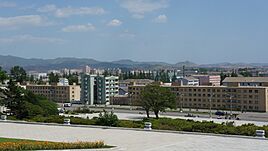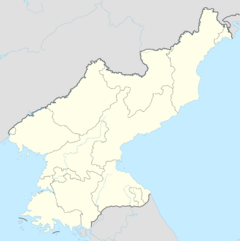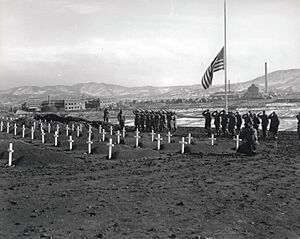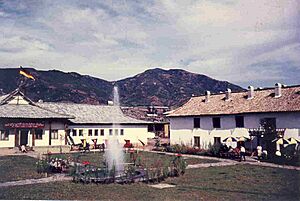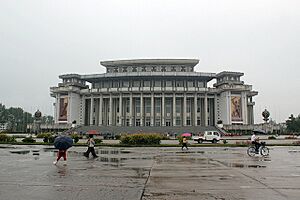Hamhung facts for kids
Quick facts for kids
Hamhŭng
함흥시
|
|
|---|---|
| Korean transcription(s) | |
| • Chosŏn'gŭl | 함흥시 |
| • Hancha | 咸興市 |
| • McCune-Reischauer | Hamhŭng-si |
| • Revised Romanization | Hamheung-si |
|
Clockwise from top: view of Hamhung city, Hamhung Royal Villa, Majon Beach Resort, an industrial plant in Hamhung, Hamhŭng Grand Theatre
|
|
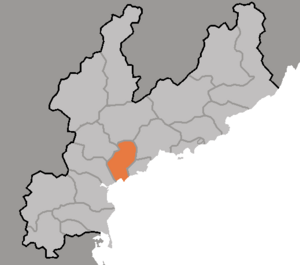
Map of South Hamgyong showing the location of Hamhung
|
|
| Country | |
| Region | Kwannam |
| Province | South Hamgyong |
| Administrative divisions | 7 kuyok |
| Area | |
| • Total | 330 km2 (130 sq mi) |
| Population
(2008)
|
|
| • Total | 768,551 |
| • Density | 2,328/km2 (6,030/sq mi) |
| • Dialect | Hamgyŏng |
| Time zone | UTC+9 (Pyongyang Time) |
Hamhŭng (Hamhŭng-si; Korean pronunciation: [hamɣɯŋ]) is the second-largest city in North Korea. It is also the capital of the South Hamgyŏng Province. You can find it in the southern part of the province. It's the biggest and most populated area there. The city was carefully planned and built by the North Korean government.
Contents
City Divisions
Hamhŭng is split into 7 main areas called guyŏk (wards). These divisions help manage the city.
City Geography
Hamhŭng is located on the Sŏngch'ŏn River. It sits on the eastern part of the Hamhŭng plain. This area is in the northeast of North Korea. The highest point near the city is Mount Tonghŭng, which is 319 meters (1,047 feet) high.
Hamhŭng's Climate
Hamhŭng has a humid continental climate. This means it has warm, humid summers and moderately cold, dry winters. Because it's near the Sea of Japan, the ocean affects its weather. This makes winters warmer and summers cooler compared to other places at the same latitude further inland. The longer period of warm weather is good for growing crops.
| Climate data for Hamhung (1991–2020) | |||||||||||||
|---|---|---|---|---|---|---|---|---|---|---|---|---|---|
| Month | Jan | Feb | Mar | Apr | May | Jun | Jul | Aug | Sep | Oct | Nov | Dec | Year |
| Mean daily maximum °C (°F) | 2.8 (37.0) |
5.2 (41.4) |
10.4 (50.7) |
17.4 (63.3) |
22.3 (72.1) |
25.3 (77.5) |
27.7 (81.9) |
28.1 (82.6) |
24.8 (76.6) |
19.5 (67.1) |
11.5 (52.7) |
4.8 (40.6) |
16.7 (62.1) |
| Daily mean °C (°F) | −3.4 (25.9) |
−1.0 (30.2) |
4.2 (39.6) |
10.8 (51.4) |
16.0 (60.8) |
19.8 (67.6) |
23.1 (73.6) |
23.5 (74.3) |
19.0 (66.2) |
12.8 (55.0) |
5.4 (41.7) |
−1.2 (29.8) |
10.8 (51.4) |
| Mean daily minimum °C (°F) | −9.0 (15.8) |
−6.7 (19.9) |
−1.3 (29.7) |
4.6 (40.3) |
10.3 (50.5) |
15.6 (60.1) |
19.6 (67.3) |
19.9 (67.8) |
14.3 (57.7) |
7.3 (45.1) |
0.2 (32.4) |
−6.3 (20.7) |
5.7 (42.3) |
| Average precipitation mm (inches) | 12.3 (0.48) |
11.2 (0.44) |
20.3 (0.80) |
44.9 (1.77) |
72.2 (2.84) |
85.3 (3.36) |
205.0 (8.07) |
172.8 (6.80) |
95.8 (3.77) |
41.8 (1.65) |
49.4 (1.94) |
19.0 (0.75) |
830.0 (32.68) |
| Average precipitation days (≥ 0.1 mm) | 3.6 | 3.1 | 4.3 | 5.4 | 7.4 | 8.5 | 12.4 | 10.9 | 6.9 | 4.6 | 5.5 | 3.3 | 75.9 |
| Average snowy days | 4.4 | 3.5 | 3.4 | 0.3 | 0.1 | 0.0 | 0.0 | 0.0 | 0.0 | 0.0 | 1.3 | 3.4 | 16.4 |
| Average relative humidity (%) | 63.6 | 61.2 | 61.4 | 61.2 | 69.4 | 78.7 | 84.0 | 84.7 | 79.9 | 71.3 | 67.0 | 63.7 | 70.5 |
| Source: Korea Meteorological Administration | |||||||||||||
City History
The city was known by different names in the past, like Hamju or Hamjumok. It got its current name, Hamhung, in 1416. The word '흥' (heung) means that the town would become successful and grow.
Yi Seong-gye, who founded the Joseon dynasty, moved to Hamhŭng after his son took power in 1400. He was so upset that he had his son's messengers killed. This led to a Korean saying, "King's envoy to Hamhŭng." It means someone who goes on a trip and is never heard from again.
During Japanese rule of Korea (1910-1945), the city was called Kankō. It was freed by the Red Army on August 22, 1945.
The city was heavily damaged during the Korean War (1950–1953) by American air raids. About 80-90% of the city was destroyed. From 1955 to 1962, East Germany helped rebuild Hamhŭng. They built new industries and trained Korean workers.
From 1960 to 1967, Hamhŭng was a special city, managed separately. But before 1960 and since 1967, it has been part of South Hamgyŏng Province.
In the 1990s, North Korea faced a severe famine. Hamhung was one of the cities most affected. Many people suffered from a lack of food. Today, foreign visitors can travel to Hamhung with approved tour groups.
City Economy
Hamhŭng has a diverse economy, meaning it has many different types of industries. This is more varied than many other cities in North Korea. The areas around the city are used for farming, mainly for growing rice.
Hamhŭng is a very important center for the chemical industry in North Korea. It is also a major port for North Korean foreign trade. The city produces things like textiles (especially a fiber called vinalon), metal products, machinery, refined oil, and processed food. A big vinalon factory, the 2·8 vinalon union enterprise, is located here.
Before Korea was freed from Japanese rule, Hamhŭng's economy was not very strong. But after liberation, the city grew quickly. New industrial areas were built. Hamhŭng now produces much of the heavy industrial equipment used in other cities. Its factories also help create materials for large construction projects.
Transportation Hub
The city is a major transportation center. It connects various ports on the eastern coast with the northern parts of the country. Hamhŭng Station is part of the Pyongra Line railway. The city also has an airport, Sondok Airport, for air travel. There is also a smaller railway line, the Soho Line, that connects West Hamhŭng to Hungnam.
Hamhŭng has a large trolleybus network. Trolleybuses are like electric buses that get power from overhead wires. The first line opened in 1973. Later, more lines were added, connecting Hamhŭng station to the Hungnam area.
City Culture
Hamhŭng is home to the Hamhŭng Grand Theatre, which is the largest theater in North Korea. There is also a national museum in the city. Hamhŭng is famous for its special dish called Hamhŭng Naengmyeon. This is a traditional Korean cold buckwheat noodle dish. Unlike the cold noodles from Pyeongyang, Hamhŭng cold noodles are often spicier and have more toppings.
Education in Hamhŭng
Hamhŭng has several important universities. These include the Hamhŭng University of Education, the Hamhŭng University of Pharmacy, the Hamhŭng University of Chemistry, and the Hamhŭng University of Medicine. There are also professional colleges, such as the Hamhŭng College of Quality Control and the Hamhŭng College of Electronics and Automation. The city also has a branch of the national academy of science.
In 2018, the South Hamgyong Sci-Tech Library opened in Hamhŭng. It is the largest library of its kind outside of Pyongyang.
Famous People from Hamhŭng
- Yi Seonggye (1335–1408), who founded the Joseon dynasty, the last royal family of Korea.
- Ahn Soo-kil (1911–1977), a South Korean writer.
- Richard E. Kim (1932–2009), a Korean American writer.
- Yoon Kwang-cho (born 1946), a South Korean ceramic artist.
- Yang Hyong-sop (1925–2022), who was the President of the Supreme People's Assembly from 1984 to 1998.
Sister Cities
Hamhŭng has a "sister city" relationship with another city:
 Shanghai, People's Republic of China (since 1982)
Shanghai, People's Republic of China (since 1982)
See Also
 In Spanish: Hamhung para niños
In Spanish: Hamhung para niños


